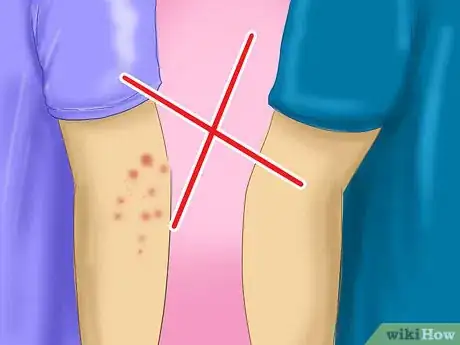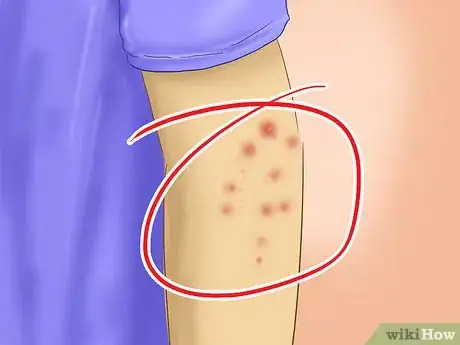This article was co-authored by Lydia Shedlofsky, DO. Dr. Lydia Shedlofsky is a Resident Dermatologist who joined Affiliated Dermatology in July of 2019 after completing a traditional rotating internship at Larkin Community Hospital in Miami, Florida. She earned a Bachelor of Science in Biology at Guilford College in Greensboro, North Carolina. After graduation, she moved to Beira, Mozambique, and worked as a research assistant and intern at a free clinic. She completed a Post-Baccalaureate program and subsequently earned a Master's Degree in Medical Education and a Doctorate of Osteopathic Medicine (DO) from the Lake Erie College of Osteopathic Medicine.
There are 7 references cited in this article, which can be found at the bottom of the page.
wikiHow marks an article as reader-approved once it receives enough positive feedback. In this case, 100% of readers who voted found the article helpful, earning it our reader-approved status.
This article has been viewed 121,989 times.
Scabies is a skin infection caused by small parasites in the skin. Its symptoms include non-stop itching that can last for up to two weeks after all the parasites have been killed. Scabies can cause severe discomfort and even hospitalization, so it is best to know when you have it and to treat it immediately. The best way to avoid catching scabies is to avoid close contact with scabies, knowing your risks of catching scabies, and identifying the symptoms of scabies. Get treatment immediately if you have scabies, since you can infect those around you.
Steps
Avoiding Close Contact with Scabies
-
1Stay away from skin-to-skin contact with an infected individual.[1] Skin-to-skin contact is the best way to catch scabies. If someone is infected with scabies, avoid close contact with them until they seek treatment.[2]
- Contact has to be prolonged to pass scabies, so gestures like a handshake will rarely pass scabies to another person.
- Longer physical contact, such as hugging or sharing a close environment with skin contact, can potentially infect someone.[3]
- Sexual intercourse is one common way to catch scabies from another person. If you had sexual intercourse with someone infected with scabies, seek treatment immediately.
-
2Avoid prolonged contact with a surface containing mites. Scabies can live for only 48 – 72 hours when not on a person. Keep away from any clothing, blankets, or linens that touched a person infected with scabies.[4]
- Towels can become infected with scabies, since they are used in close contact with those infected. Avoid handling infected towels without gloves.
- Linens and bedsheets can also become infected with scabies. Take them off any beds and immediately launder them — this should be done on the first day of treatment.
- Clothing can also carry scabies. Any clothing that an infected person wore in the last 72 hours can still have mites on them and should be washed.
Advertisement -
3Wash or isolate any materials infected with scabies thoroughly. It's important to clean or quarantine surfaces that may still be carrying scabies. This will help to stop it from spreading to other people.[5]
- If possible, wash anything that has come into contact with those infected with scabies. Use the hottest water possible and dry them using the hottest setting. [6]
- You can also dry clean anything that has come into contact with an infected person. Make sure to tell the dry cleaners, though, so they can take special precautions to avoid a scabies infestation of their own.
- When you can't wash the material infected with scabies, keep it sealed and away from others. Place infected material in plastic bags that are tightly sealed with as little air as possible in the bag. Keep the bags sealed for at least one week.
- Items that have not touched your skin for more than one week likely will not need to be washed.
Knowing Your Risk for Scabies
-
1Be careful if you’re in a group susceptible to scabies infection. Certain groups or people are more susceptible to being infected with scabies, mostly because they are more likely to have skin-to-skin contact with others, which is the only way that you can catch scabies. If you’re a member of one or more of these groups, be careful and aware of any symptoms of scabies.
- Children are vulnerable to scabies. They can acquire it from being in communal environments in which scabies is more common.
- Mothers of young children are very susceptible to scabies. They often catch scabies from their children first before passing it on to others.
- Sexually active people can also acquire scabies. Scabies is most easily contracted as a result of prolonged skin-to-skin contact.
- People living in nursing homes or similar environments. The elderly or those living in close quarters can also get scabies because they are in close contact with many people.
- People in confinement, in places like prison, are also at risk of contracting scabies.
-
2Be aware of your environmental risks for scabies. Scabies do not spread in dirty environments; the scabies mite simply wants to stay on human skin. This means that some environments, such as the following, are especially ripe for a scabies infestation:
- College dormitories are a common place to catch scabies, since so many people are coming into contact with one another and the outside world. Places like a communal bathrooms are somewhere to easily catch scabies.
- Nursing homes are another place to catch scabies. Since so many people are in close quarters, scabies can easily spread among the residents.
- Childcare centers can also spread scabies. It’s not because the children are dirty, but rather because one person infected can easily infect others through skin-to-skin contact.
- Classrooms can also spread scabies, since children are constantly coming and going from the outside and are around one another for long periods of time.
- Camps are another place to catch scabies. The mixture of a variety of people in close quarters can spread scabies.
-
3Realize that animals cannot spread scabies. While animals may have other ticks or mites, they cannot spread scabies to humans. Skin-to-skin contact with another human is the only way to catch scabies.[7]
- For dogs, scabies is called mange. This produces a slight itch on human skin, but goes away quickly.
- Bring your pet to the doctor if they are exhibiting symptoms of mange such as itching or hair loss.
- Scabies from dogs will not cause human scabies. If you get scabies, it's from another human, not from your pet even if they have mange.
Recognizing the Symptoms of Scabies
-
1Identify the symptoms. There are several symptoms of scabies, and they range from minor to extreme. Knowing the symptoms won't necessarily help you avoid catching them, but may help you know if you need to move on to curing them.[8]
- Itching is a symptom of scabies that persists at night. It is the most common symptom, and can be so intense that it keeps those who are infected awake at night.
- Many people affected by scabies get a rash. The rash from scabies appears as little bumps, usually in a line, and can look like tiny bites, knots, or even pimples. The rash can be confused with eczema because of their similarities.
- Sores from scabies are only caused by intense scratching. After the sores have developed, the risk of infection greatly increases. Staph and strep may infect the skin.
- Thick crusts on the skin can form from a severe type of scabies. These crusts hold hundreds and even thousands of mites, along with their eggs, and greatly increase the itch, as well as making the rash more extreme.
-
2Look out for particular spots. Understand that there are particular areas scabies tend to form, because the mites prefer them over the rest of the body.[9]
- Scabies often attack the hands. In particular, they can be found between the fingers and around the nails.
- Arms are a common place to find scabies infections. The elbows and wrists are particularly vulnerable to infection.
- Skin covered by clothing is often infected. Most commonly, the belt-line, penis, buttocks and skin surrounding the nipples can become affected; however, anything that clothing or jewelry covers is also a likely place for scabies to develop.
- In children the spots to watch out for scabies include scalp, face, neck, palms of hands, and soles of feet.
-
3Get treatment immediately if you have scabies.[10] A scabies infection is serious. Additionally, untreated scabies can cause you to pass the infection along to other people with whom you have skin-to-skin contact.[11]
- If a person has scabies, get them to a physician or dermatologist immediately. Not only can severe cases cause hospitalization, but scabies aren't treatable without medication available by prescription.
- Creams, such as 5% permethrin cream and lindane lotion, are most commonly prescribed to solve the scabies infection. In more severe cases, such as crusted scabies, an oral medication such as ivermectin may be prescribed.
- Untreated scabies can continue the infection throughout an at-risk environment. If you think you have scabies, go see a doctor immediately to avoid passing it onto others.
Expert Q&A
Did you know you can get expert answers for this article?
Unlock expert answers by supporting wikiHow
-
QuestionWhat do I do if my child has scabies?
 Lydia Shedlofsky, DODr. Lydia Shedlofsky is a Resident Dermatologist who joined Affiliated Dermatology in July of 2019 after completing a traditional rotating internship at Larkin Community Hospital in Miami, Florida. She earned a Bachelor of Science in Biology at Guilford College in Greensboro, North Carolina. After graduation, she moved to Beira, Mozambique, and worked as a research assistant and intern at a free clinic. She completed a Post-Baccalaureate program and subsequently earned a Master's Degree in Medical Education and a Doctorate of Osteopathic Medicine (DO) from the Lake Erie College of Osteopathic Medicine.
Lydia Shedlofsky, DODr. Lydia Shedlofsky is a Resident Dermatologist who joined Affiliated Dermatology in July of 2019 after completing a traditional rotating internship at Larkin Community Hospital in Miami, Florida. She earned a Bachelor of Science in Biology at Guilford College in Greensboro, North Carolina. After graduation, she moved to Beira, Mozambique, and worked as a research assistant and intern at a free clinic. She completed a Post-Baccalaureate program and subsequently earned a Master's Degree in Medical Education and a Doctorate of Osteopathic Medicine (DO) from the Lake Erie College of Osteopathic Medicine.
Dermatologist
-
QuestionHow do you care for someone with scabies?
 Lydia Shedlofsky, DODr. Lydia Shedlofsky is a Resident Dermatologist who joined Affiliated Dermatology in July of 2019 after completing a traditional rotating internship at Larkin Community Hospital in Miami, Florida. She earned a Bachelor of Science in Biology at Guilford College in Greensboro, North Carolina. After graduation, she moved to Beira, Mozambique, and worked as a research assistant and intern at a free clinic. She completed a Post-Baccalaureate program and subsequently earned a Master's Degree in Medical Education and a Doctorate of Osteopathic Medicine (DO) from the Lake Erie College of Osteopathic Medicine.
Lydia Shedlofsky, DODr. Lydia Shedlofsky is a Resident Dermatologist who joined Affiliated Dermatology in July of 2019 after completing a traditional rotating internship at Larkin Community Hospital in Miami, Florida. She earned a Bachelor of Science in Biology at Guilford College in Greensboro, North Carolina. After graduation, she moved to Beira, Mozambique, and worked as a research assistant and intern at a free clinic. She completed a Post-Baccalaureate program and subsequently earned a Master's Degree in Medical Education and a Doctorate of Osteopathic Medicine (DO) from the Lake Erie College of Osteopathic Medicine.
Dermatologist
-
QuestionHow does scabies spread?
 Lydia Shedlofsky, DODr. Lydia Shedlofsky is a Resident Dermatologist who joined Affiliated Dermatology in July of 2019 after completing a traditional rotating internship at Larkin Community Hospital in Miami, Florida. She earned a Bachelor of Science in Biology at Guilford College in Greensboro, North Carolina. After graduation, she moved to Beira, Mozambique, and worked as a research assistant and intern at a free clinic. She completed a Post-Baccalaureate program and subsequently earned a Master's Degree in Medical Education and a Doctorate of Osteopathic Medicine (DO) from the Lake Erie College of Osteopathic Medicine.
Lydia Shedlofsky, DODr. Lydia Shedlofsky is a Resident Dermatologist who joined Affiliated Dermatology in July of 2019 after completing a traditional rotating internship at Larkin Community Hospital in Miami, Florida. She earned a Bachelor of Science in Biology at Guilford College in Greensboro, North Carolina. After graduation, she moved to Beira, Mozambique, and worked as a research assistant and intern at a free clinic. She completed a Post-Baccalaureate program and subsequently earned a Master's Degree in Medical Education and a Doctorate of Osteopathic Medicine (DO) from the Lake Erie College of Osteopathic Medicine.
Dermatologist
References
- ↑ Lydia Shedlofsky, DO. Dermatologist. Expert Interview. 11 November 2020.
- ↑ https://www.cdc.gov/parasites/scabies/prevent.html
- ↑ Lydia Shedlofsky, DO. Dermatologist. Expert Interview. 11 November 2020.
- ↑ http://www.cdc.gov/parasites/scabies/gen_info/faqs.html
- ↑ https://www.plannedparenthood.org/learn/stds-hiv-safer-sex/scabies/how-can-i-prevent-getting-or-spreading-scabies
- ↑ https://www.aad.org/public/diseases/contagious-skin-diseases/scabies#tips
- ↑ https://www.cdc.gov/parasites/scabies/gen_info/faqs.html
- ↑ https://my.clevelandclinic.org/health/diseases/4567-scabies
- ↑ https://my.clevelandclinic.org/health/diseases/4567-scabies
- ↑ Lydia Shedlofsky, DO. Dermatologist. Expert Interview. 11 November 2020.
- ↑ https://my.clevelandclinic.org/health/diseases/4567-scabies
- ↑ Lydia Shedlofsky, DO. Dermatologist. Expert Interview. 11 November 2020.
About This Article
To identify and prevent scabies, avoid making skin-to-skin contact with an infected individual. You should also stay away from any clothing or bedding used by an infected person, since scabies mites can live for 48 to 72 hours on them. When you have to deal with infested clothing, wash it separately on the hottest setting of your machine to prevent scabies from spreading. If you think you may have scabies, look out for itching that can persist throughout the night. Additionally, you may see tiny bite marks in lines on your hands or arms, sores, and crusty skin. To learn more from our Medical co-author, including which groups of people are most at risk of scabies, read on!







































































Medical Disclaimer
The content of this article is not intended to be a substitute for professional medical advice, examination, diagnosis, or treatment. You should always contact your doctor or other qualified healthcare professional before starting, changing, or stopping any kind of health treatment.
Read More...